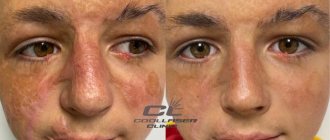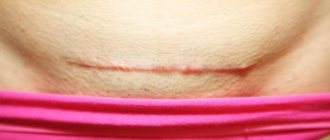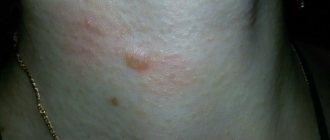Surgical intervention involving skin incisions does not pass without leaving a trace. Scars remain on the surface of the body. Some of them are small and unnoticeable, while others are large, bright, protruding above the surface of the skin.
It is completely impossible to remove scars after surgery, but it is quite possible to make them miniature and light. Modern cosmetology procedures will help with this.
Types of scars
Postoperative scars are a consequence of intensive growth of connective tissue in the area of skin damage. They can have different shades, sizes and shapes. The following types of scars after surgery are distinguished:
- Normotrophic. Does not protrude above the surface of the epidermis and does not differ from the skin in color.
- Atrophic. It looks like a small depression. Appears when there is insufficient amount of collagen.
- Hypertrophic. Protrudes above the surface of the skin and has a pink tint.
- Keloid. It has the shape of an elevation and a bluish tint. The skin in the affected area is tight, dry, and may peel. Often the patient is bothered by itching. Over time, keloid scars increase in size.
Scar removal after surgery is an optional procedure. If the scar is small, pale and located on an area of the body that can be easily hidden with clothing, you can refuse the procedure. If the scar causes discomfort and is noticeable to others, it is better not to wait, but to immediately contact a surgeon or cosmetologist.
Effective ways to treat scars
Scars and scars are treated in different ways. The specific type of treatment is selected by the doctor depending on the cause, the patient’s condition, concomitant diseases and other factors. The main methods of therapy are:
- Special creams - for example, Imoferase, Dermatix, Naftaderm, Contractubex, Clofibraza, Narbiril and others.
- Chemical peeling - this method is used in cases where treatment with ointments is ineffective.
- Introduction of dermal fillers based on hyaluronic acid or collagen. These components not only smooth the surface of the skin, but also activate collagen synthesis by the body itself.
- Laser therapy can eliminate the most noticeable scars. They are destroyed under the influence of laser radiation, as a result of which collagen synthesis also increases.
- Surgery is indicated in extreme cases when scar tissue needs to be removed. It is possible to transplant a small part of the skin or dermotension.
Scars after surgery: what to do at home
A conservative approach is appropriate for small, fresh scars. In complex cases, treatment of scars after surgery involves the use of cosmetic procedures or surgical excision if other methods have not led to a positive result.
At home, you can use drugs with different pharmacological effects:
- accelerating regeneration;
- improving blood circulation;
- immunomodulatory.
It is possible to use ointments and gels containing enzymes to inhibit the rapid growth of new tissue or stimulate the synthesis of your own collagen. It is important to remember that scar correction after surgery is a long process. The drugs must be used for several months.
Difficult decoration
Scars spoil the appearance, become a source of psychological discomfort, and if we are talking about surgical scars - the “epilogue” of surgical interventions - then they can disrupt the functions of organs and tissues. Cosmetology, dermatology and plastic surgery jointly deal with scar issues.
Scar is connective tissue
, which is formed at the site of a violation of the integrity of the skin (due to mechanical trauma, burns, surgery, various dermatoses, etc.), accompanied by inflammation. It does not have a skin pattern and looks unnatural against the general background of the skin.
Of course, not every injury leaves a scar. Damage to the skin up to the papillary dermis
, as a rule, heals without a trace. And even if the skin is injured at the level of the papillae, under certain conditions it can heal without scars.
How to remove scars after surgery: modern cosmetic procedures
If there is a large scar left on the body after surgery, it is better to remove it using cosmetic procedures. Modern methods are safe and effective. There are several options for eliminating scars after surgery:
- Filling with collagen. A method recommended only for atrophic scars. It involves filling the depression with collagen and leveling the surface. The effect lasts for 12 months.
- Cryodestruction. The method involves treating the scar with liquid nitrogen. Damaged tissue is frozen and destroyed, and healthy skin grows in its place. The disadvantage of the method is pain, requiring anesthesia.
- Microwave therapy. The epidermis is exposed to electromagnetic waves, which allows you to achieve lasting results. In some cases, additional cryodestruction is required.
- Microdermabrasion. The surface of the epidermis is polished using chemical compounds - acids, powdered aluminum oxide. The downside is the ability to work only with small superficial scars.
- Dermabrasion. Another grinding option involves the use of special brushes. When carried out correctly, the procedure is safe, but violation of the technique can lead to the formation of new scars.
- Bukki-irradiation. The skin is treated with ultra-soft x-rays, which initiate the reverse development of the scar. The method is used for keloid and hypertrophic scars, but is prohibited in case of circulatory problems.
- Laser irradiation. The most common method recommended by doctors who tell how to get rid of scars after surgery. The method is suitable for different types of skin changes. Laser scar resurfacing is a quick procedure that is performed under local anesthesia.
Surgical intervention
In rare cases, when a scar causes significant discomfort, and a course of laser scar removal after surgery did not help, plastic surgery methods are resorted to. During the manipulation, the doctor excises the damaged tissue and transplants a skin flap of the patient taken from another area. The entire process takes about an hour and is performed under general anesthesia. Next begins the rehabilitation period, which may take several months.
Chemical peeling
Peeling is the destruction of scar tissue due to the action of various organic acids. They also help optimize fat metabolism, which can also help get rid of acne. There are several types of chemical peeling (depending on the reagent used):
- TCA peeling (using 3-chloroacetic acid with a concentration of 35-50%).
- Retinoic (based on retinoic acid, which not only destroys scars, but also has an antibacterial effect).
- Phenolic (phenol-based - it also helps get rid of scars and destroys bacteria). However, phenol is toxic and can have a bad effect on the nervous system.
Chemical peeling is contraindicated in the following cases:
- recurrence of acne;
- tendency to keloid scars;
- wounds, neoplasms;
- individual intolerance to the substances used.
Hard case
Keloid scars sometimes occur without any effect on the skin. Spontaneous keloids
- convex skin growths are therefore spontaneous because they manifest themselves without external causes.
There is a concept of keloid constitution
; By the way, it is relatively common among people of the dark race. In addition, experts talk about keloid zones, which are the most prone to the development of this kind of scars. These are the face, ears, neck, shoulder girdle, upper back and chest.
In cosmetology practice, there are cases when the removal of small defects (say, pinpoint papillomas in the décolleté area) causes the formation of keloids the size of a coin! Taking certain medications, such as isotretinoin, can also cause the formation of keloid scars.
Before undergoing a chemical peel or laser resurfacing, your doctor should ask you about your keloid susceptibility. True, it is very difficult to predict whether a scar will appear at the site of exposure or not. Fabrics can behave unpredictably.
Laser
In this case, no interventions are performed, the surrounding tissues are not damaged, and no stitches are applied.
Old scars can be removed with laser in 7-10 sessions, with breaks between them being 1-2 months. Under the influence of the beam, the accelerated production of fibroblasts occurs, which synthesize collagen fibers. After the first procedure, the scar becomes slightly discolored. Then the “old” tissues are destroyed, gradually smoothed out and compared in structure and color with healthy skin.
Proper care after completing the course is not complicated: it includes treating the laser treatment area with a special ointment, protecting the skin from high temperatures and ultraviolet radiation. In some cases, according to the doctor's decision, antibiotics or painkillers are prescribed.
Surgical
Used to remove old scars resulting from burns, gunshot wounds or other accidents, as well as after surgery.
The procedure is performed using local anesthesia or general anesthesia:
- The old scar is removed (cut);
- Carefully connect the edges of the wound;
- The thinnest threads are used to place sutures slightly lower and parallel to the skin surface.
On the third or fourth day after surgery, the sutures can be removed.
The duration of the recovery period is no more than five days. During this time and the next few weeks, strict adherence to all recommendations of the surgeon is required, including undergoing a course of cosmetic procedures or physical therapy.
How to get rid of old scars with surgery
The most radical of all methods involves excision of the scar or transplantation of a flap of skin - in this case, as a rule, plastic surgery is performed and the replacement of a fragment of skin is nothing more than a consequence of the operation. With proper transplantation, there should be no scars left at all.
However, the operation is associated with certain risks and contraindications. For example, excision can be performed only if the scar is more than 6 months old. During pregnancy and breastfeeding, surgery is strictly prohibited, and the procedure is not performed for chronic diseases in the acute stage, skin diseases at the site of the scar, poor blood clotting, mental disorders and cardiovascular pathologies.
After surgery, unpleasant consequences are possible, such as:
- inflammation of the operated area and bleeding;
- the occurrence of hematomas;
- necrosis of the skin flap if a transplant was performed;
- neuralgia.
Excision is performed if the scar is large and noticeable in everyday life. After the procedure it becomes smaller, but does not disappear.
Injectable
To remove old scars, they are filled with special preparations - hyaluron, collagen or lipofillers (adipose tissue) injected under the skin.
The procedure is carried out in several stages:
- An anesthetic cream is applied to the damaged area to relieve discomfort from the intradermal injection;
- The skin is cleaned and treated with an antiseptic to protect against infection;
- Injections are administered directly into the scar. Medical personnel strictly control the dosage of the drug, and the number of punctures depends on the characteristics of the scar and is determined separately for each case;
- Antiseptic is reapplied to the area.
Treatment methods
Apart from surgery, there are several ways to treat scars: cryotherapy, wearing compression garments, using silicone preparations, enzyme injections and hormone therapy. But the most effective, safe for the patient and widespread method is laser therapy.
The laser has a highly precise impact with controlled depth, allowing it to avoid damaging healthy tissue. The procedures cause virtually no discomfort, and the recovery period is minimal. The laser removes “extra”, that is, scar tissue and stimulates the production of collagen - the irradiation site heals, and after several procedures not even a trace remains of the scar. The number of procedures is individual, depending on the age of the scar and your characteristics.
To enhance the effect of the laser and stimulate the smoothing of skin relief, plasma lifting is used. The patient is injected with plasma from his own blood into the scar area. This procedure allows the skin to recover faster and stimulates the production of natural collagen and elastin. Plasmolifting is also effective in the treatment of acne. The second option for injection “assistance” with laser is mesotherapy. We use only drugs that are approved by the Ministry of Health of the Russian Federation and have all the necessary quality certificates.
Chemical peeling will also help smooth out small scars - it is effective in working with small atrophic scars. A series of peelings allows you to even out the texture of tissues and skin color.
Special medications can be used to treat keloid scars. They are prescribed only by a doctor - consultation is required!









